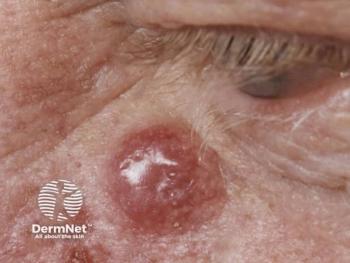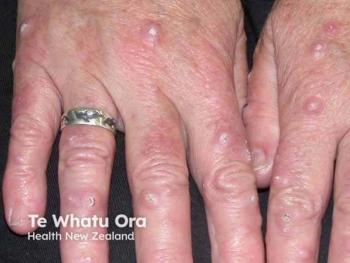
- Dermatology Times, August 2019 (Vol. 39, No. 8)
- Volume 39
- Issue No. 8
New AAD cSCC treatment guidelines
The new AAD cSCC treatment guidelines highlight alternative therapeutic or preventive treatment options.
Of the nonmelanoma skin cancers, cutaneous squamous cell carcinoma (cSCC) is the second most common, and although cSCCs often can be treated in an office setting, unchecked advanced tumors pose a significant risk for morbidity and mortality.
Currently, the most commonly followed guidelines for the care of nonmelanoma skin cancer are those proposed by the National Comprehensive Cancer Network (NCCN), which encompass basal cell carcinoma, squamous cell carcinoma, Merkel cell carcinoma, and dermatofibrosarcoma protuberans.
“The NCCN guidelines, though extremely thorough and authoritative, can be more than the typical clinician requires, given the interplay of flow charts, notes, and text, whereas the new AAD guidelines are written primarily as a single narrative meant to be approachable and communicative to the reader,” said Murad Alam, M.D., FAAD, co-chair of the American Academy of Dermatology cSCC treatment guidelines work group. The group published updated guidelines in March in the Journal of the American Academy of Dermatology.
“The guidelines we put forth reflect the most common treatment modalities used by dermatologists when addressing cSCC, particularly primary tumors, and help to reinforce the standard of care for their patients,” he said.
TREATMENT MODALITIES FOR cSCC
1. GRADING AND STAGING
Currently, there is no widely accepted optimal staging system for risk stratification of cSCC, although both AJCC and BWH staging systems are used. Staging imaging studies are not always indicated for cSCC because of the low overall risk for nodal and distant metastasis associated with the more numerous smaller tumors. However, they can be useful in assessing for deep structural involvement with extensive localized disease. Clinical examination of the regional lymph nodes is routinely performed.
2. BIOPSY
Punch, shave, and excisional biopsy techniques can all be used, and the procedure of choice depends on several factors including the clinical characteristics of the suspected tumor, expected histological subtype and depth, natural history, and anatomic location. Other factors such as bleeding and wound healing, as well as patient preference and physician judgement must be considered.
a. Clinical and pathologic information
Clinical morphology, anatomic location, and patient-reported history all contribute towards a presumptive diagnosis of cSCC, and biopsy will typically confirm the diagnosis. Important information provided to the pathologist when submitting biopsy tissue includes patient age and gender, clinical presentation and anatomical location, and any history of treatment at the same anatomic site. Additional helpful information may include clinical size of the lesion, or the existence of other risk factors such as immunosuppression, radiation treatment, or solid organ transplantation.
3. SURGICAL TREATMENT
For the vast majority of cSCCs, surgical excision remains the first line of treatment. However, clinicians must always be vigilant for a subset of tumors with increased risk for local recurrence, perineural spread, and nodal or distant metastasis, particularly in immunocompromised patients.
a. Standard excision
A complete removal of the tumor can be achieved following a “bread loaf” excision that includes a margin of clinically normal-appearing skin around the tumor and surrounding erythema. NCCN guidelines recommend 4-6 mm clinical margins for standard excision of low-risk cSCC.
b. MMS
Mohs micrographic surgery provides a controlled excision and is very useful and recommended for recurrent or poorly defined (i.e. higher risk) tumors and tumors at cosmetically and functionally sensitive sites when tissue sparing is important.
c. C&E
This method can be effectively used for the treatment of small, low-risk cSCC, although results are highly operator and technique dependent. Compared to standard excision, longer healing times and suboptimal cosmetic outcomes may be expected and therefore cosmetically sensitive areas should be avoided.
4. NONSURGICAL TREATMENT
If first-line surgical therapy is not feasible or contraindicated, nonsurgical modalities can be considered, however they are associated with lower cure rates.
a. PDT
Available data for PDT and laser therapy do not currently support the efficacy of either modality in the treatment of cSCC, however it can be used as an adjunct therapy to curettage and surgery in high-risk select cases.
b. Topical therapies
The use of topical modalities for the treatment of cSCC including 5-fluorouracil and imiquimod is not currently supported by the literature.
c. Radiation therapy
This modality is experiencing a kind of resurgence and can be effective in select cases resulting in good tumor control and cosmesis, with smaller and thinner tumors showing a higher response rate. Primary radiation therapy can be implemented when first line surgery procedures are not feasible, contraindicated, or preferred by the patient after appropriate consultation of the risks and benefits.
d. Cryosurgery
Due to the lack of histologic margin control, it is recommended that cryosurgery only be implemented for low-risk lesions when possible.
5. MANAGING PATIENTS WITH METASTATIC CSCC
cSCC is reported to metastasize in approximately 4% of cases, and the metastatic risk can be 2-3 times higher in immunosuppressed patients such as organ transplant recipients. Although sentinel lymph node biopsy (SLNB) has been shown to detect occult lymph node metastasis in patients with high-risk localized tumors, the effect of this procedure on management and outcome of patients with high-risk cSCC is poorly described. Choice of treatment is based on disease extent and consists primarily of surgical excision with possible lymph node dissection, and consideration of adjuvant radiation therapy with or without concurrent systemic therapy. As most cases of metastatic cSCC are complex, a multidisciplinary approach is highly recommended.
6. FOLLOW-UP AND REDUCING RISK FOR FUTURE SKIN CANCERS
Once a cSCC diagnosis is made, at least yearly screenings should be performed for all NMSC and melanoma as well, which could include clinical assessment of regional lymph node basins for higher risk lesions.
Patients should also be taught and regularly practice at-home skin surveillance, as well as use appropriate sun protective measures.
“Skin cancer is a central part of dermatology and we are trying to provide an easily accessible guidelines format so dermatologists who are strapped for time can quickly read this document and be apprised of the current standard of management of primary cSCC,” Dr. Alam said.
REFERENCE
“Guidelines of care for the management of cutaneous squamous cell carcinoma,” Journal of the American Academy of Dermatology. March 2018. DOI:10.1016/j.jaad.2017.10.007
Articles in this issue
over 7 years ago
Communication in the era of patient-centered careover 7 years ago
Comprehensive psoriasis managementover 7 years ago
Dermatology training for nurses and PAsover 7 years ago
Is it time to regulate probiotics in cosmetics?over 7 years ago
11 steps to improving doctor-patient communicationover 7 years ago
EC moves forward with new PsA treatmentover 7 years ago
Make patient-centered work in practiceover 7 years ago
Emotional burden of skin conditions may be rooted in physiologyover 7 years ago
Outlook for new botulinum toxins in the U.S. marketNewsletter
Like what you’re reading? Subscribe to Dermatology Times for weekly updates on therapies, innovations, and real-world practice tips.


















